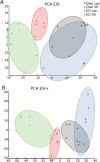Systemic resistance in citrus to Tetranychus urticae induced by conspecifics is transmitted by grafting and mediated by mobile amino acids
- PMID: 27683726
- PMCID: PMC5066491
- DOI: 10.1093/jxb/erw335
Systemic resistance in citrus to Tetranychus urticae induced by conspecifics is transmitted by grafting and mediated by mobile amino acids
Abstract
Recent research suggests that systemic signalling and communication between roots and leaves plays an important role in plant defence against herbivores. In the present study, we show that the oviposition of the two-spotted spider mite Tetranychus urticae in the systemic leaves of citrus rootstock Citrus aurantium (sour orange) was reduced by 50% when a lower leaf was previously infested with conspecifics. Metabolomic and gene expression analysis of the root efflux revealed a strong accumulation of glutamic acid (Glu) that triggered the expression of the citrus putative glutamate receptor (GRL) in the shoots. Additionally, uninfested sour orange systemic leaves showed increased expression of glutamate receptors and higher amounts of jasmonic acid (JA) and 12-oxo-phytodienoic acid in plants that were previously infested. Glu perception in the shoots induced the JA pathway, which primed LOX-2 gene expression when citrus plants were exposed to a second infestation. The spider mite-susceptible citrus rootstock Cleopatra mandarin (C. unshiu) also expressed systemic resistance, although the resistance was less effective than the resistance in sour orange. Surprisingly, the mobile signal in Cleopatra mandarin was not Glu, which suggests a strong genotype-dependency for systemic signalling in citrus. When the cultivar Clemenules (C. clementina) was grafted onto sour orange, there was a reduction in symptomatic leaves and T. urticae populations compared to the same cultivar grafted onto Cleopatra mandarin. Thus, systemic resistance is transmitted from the roots to the shoots in citrus and is dependent on rootstock resistance.
Keywords: Tetranychus urticae.; Citrus; glutamate-receptor like; glutamic acid; grafting; systemic resistance.
© The Author 2016. Published by Oxford University Press on behalf of the Society for Experimental Biology.
Figures










References
-
- Agut B, Gamir J, Jacas JA, Hurtado M, Flors V. 2014. Different metabolic and genetic responses in citrus may explain relative susceptibility to Tetranychus urticae . Pest Management Science 70, 1728–1741. - PubMed
-
- Agut B, Gamir J, Jacas JA, Flors V. 2015. Tetranychus urticae-triggered responses in citrus promote genotype-dependent conspecific repellence or attractiveness. New Phytologist 207, 790–804. - PubMed
-
- Ankala A, Kelley RY, Rowe DE, Williams WP, Luthe DS. 2013. Foliar herbivory triggers local and long distance defense responses in maize. Plant Science 199, 103–112. - PubMed
-
- Balmer A, Pastor V, Gamir J, Flors V, Mauch-Mani B. 2015. The ‘prime-ome’: towards a holistic approach to priming. Trends in Plant Science 20, 443–452. - PubMed
-
- Bruessow F, Asins MJ, Jacas JA, Urbaneja A. 2010. Replacement of CTV-susceptible sour orange rootstock by CTV-tolerant ones may have triggered outbreaks of Tetranychus urticae in Spanish citrus. Agriculture, Ecosystems & Environment 137, 93–98.
Publication types
MeSH terms
Substances
LinkOut - more resources
Full Text Sources
Other Literature Sources
Molecular Biology Databases

